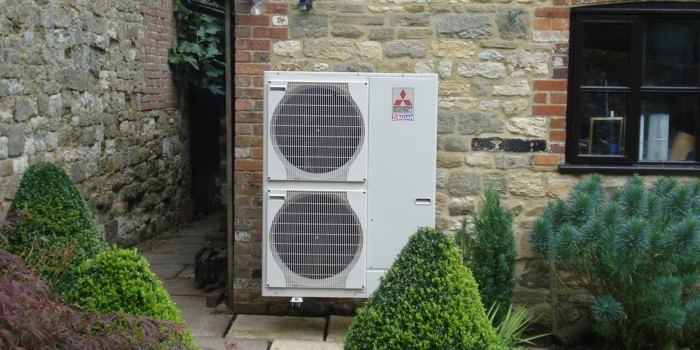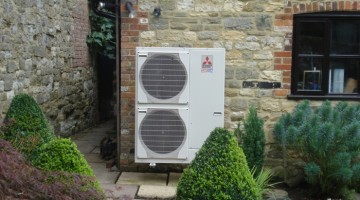
Read This Before Installing a Heat Pump
In June last year, I moved into a new property in Oxfordshire. The house, I guess, could be considered a new build since it was built in the last couple of years, and the assumption is that it has been built to building regulations, therefore there is a huge amount of insulation within the fabric of the building, ensuring it was very energy efficient.
In addition to the insulation, there is also an air source heat pump, which despite knowing a fair bit about is actually a technology I have not yet lived with until now. Heat pumps are currently a very ‘in’ technology since there are generous government grants to cover a large part of the install cost of the unit – with the Government looking to incentivise households to make the switch from gas boilers.
They use electricity to run, and basically remove any latent heat from the air, compress it (which is what uses much of the electricity) to drive the temperature up further and then this heat is used to heat the home. Unlike gas boilers which can make really hot water (60-80 degrees), the water that a heat pump makes in much cooler (35 to 55 degrees), this is known as the flow temperature.
The flow temperature of a heating system is the temperature at which the heated water is circulated from the heat source (like a heat pump or gas boiler) to the radiators or underfloor heating. Typically because of the lower flow temperature of heat pumps, they tend to work much better when coupled with underfloor heating.

And often, when switching from a gas boiler to a heat pump, it may be necessary to upgrade the home’s insulation and heating distribution system (like installing larger radiators or underfloor heating) to ensure efficient operation and comfort.
It is this reason often that you hear the horror stories about heat pumps. Households are offered generous grants to make the switch. The installers are pushing the heat pumps on homeowners because they make good money from installing them, but unfortunately in many cases they just aren’t appropriate – the lack of insulation or the lack of an appropriate heat dispersal system (e.g. radiators).
The result is considerably higher energy bills – as the price of electricity is far higher than gas like for like. Unfortunately, this is made worse by the weather getting colder since the heat pump needs to work harder to get the flow temperature up to an adequate level.
So – coming back to my current property – lots of insulation, underfloor heating – so the heat pump should be a match made in heaven, right? Wrong!
In the first 18 days of January, I was charged £506.03 for electricity. As you might expect, on the basis that I work in the energy-saving field, the thermostats are turned right down, we have LED lighting everywhere, and generally, we run an efficient home – so imagine my shock when I received my statement from E.On.
Now, I briefly mentioned that heat pumps need to work harder in the winter. And to be honest even if we had a gas boiler in the house, I would have expected a higher bill in Jan, especially this year with it being so cold. The issue for me, is that people don’t do their research before installing heat pumps, especially when they are offered them free or with generous discounts.
There are two major metrics when it comes to heat pump performance – Coefficient of Performance (CoP) and Seasonal Performance Factor (SPF).
Coefficient of Performance (COP):
- Definition: The COP of a heat pump is a measure of its efficiency at a specific moment in time. It is calculated as the ratio of the heat output (or cooling provided) to the electrical energy input.
- Formula: COP = Heat Output (in Watts) / Electrical Energy Input (in Watts).
- Context of Use: The COP is typically measured under specific, standardised conditions. It doesn’t take into account variations in outside temperature or other factors that might affect performance over time.
- Interpretation: A higher COP means greater efficiency. For example, a COP of 3 means that for every unit of electricity used, three units of heat are produced.
Seasonal Performance Factor (SPF):
- Definition: The SPF is a measure of a heat pump’s efficiency over a season. It takes into account variations in temperature and other conditions over time.
- Formula: SPF = Total Heat Output (over a season) / Total Electrical Energy Input (over the same season).
- Context of Use: SPF provides a more realistic and comprehensive measure of a heat pump’s efficiency in real-world conditions over a longer period, often a heating or cooling season.
- Interpretation: Like COP, a higher SPF indicates greater efficiency. However, the SPF will typically be lower than the COP because it includes periods of less optimal operation, such as during very cold temperatures.
The issue is that there is no requirement for heat pump manufacturers to disclose the Seasonal Performance Factor (SPF) specifically for winter conditions. So, while on paper, a heat pump with a COP of 3 looks good (3 units of heat for every unit of electricity), which broadly brings them in line with the gas when comparing the cost per unit of electricity and gas – the issue is that when you need the heat (i.e. in the winter months), the actual efficiency of the heat pump is much, much lower.
This blog is just to make people aware of some of the pitfalls associated with getting a heat pump, however a few words of advice!
- Some manufacturers voluntarily provide detailed performance data, including winter SPF, to demonstrate the effectiveness of their products in colder climates. This information is often found in technical datasheets or promotional materials, especially for models designed to perform well in cold weather. Make sure you check this out before getting the heat pump installed in your house.
- Ensure that you have a really well insulated home before even considering a heat pump, I am talking in excess of 200mm of insulation in the loft, and 90mm of EPS insulation / 100mm of mineral wool on the walls (ideally insulated externally) to bring the wall’s u-value down to 0.3.
- Make sure you have a way of dealing with the lower flow temperature, so you need to replace old radiators with bigger new ones or even install underfloor heating.
Any questions – feel free to ask in the comments below!












Hi loved the report. As an ex-electrical engineer who cared about workmanship, pride & other adjectives not often used your report was spot on. I am literally desperate to install air source pumps & PVs, however at the moment it’s not going to happen, for all your reasons & lets not forget the cost & radicles payback time. The office of National Statistic showed that as the UK Gov removed the FIT from private dwelling & the graph plunged, industry’s graph was inverse, There is a message in that graph! All new homes under building reg’s should be mandatory. So yet again our politicians let us down.